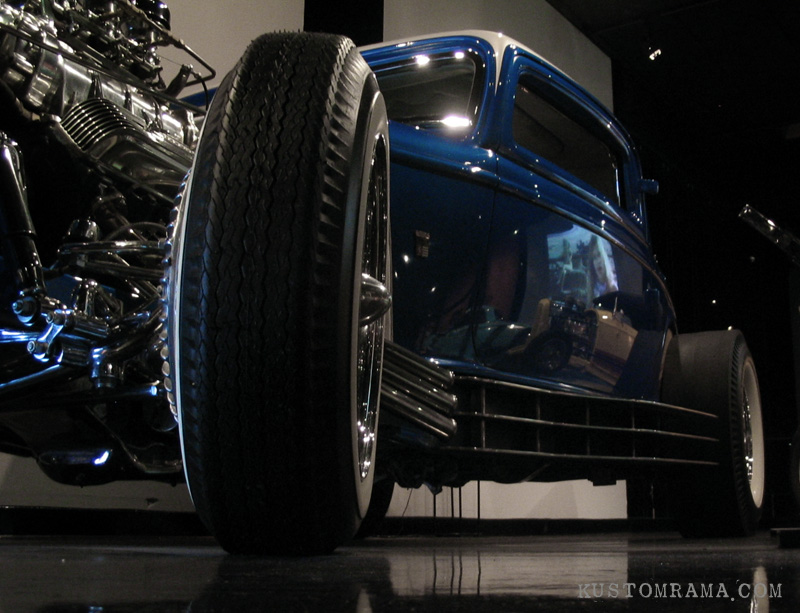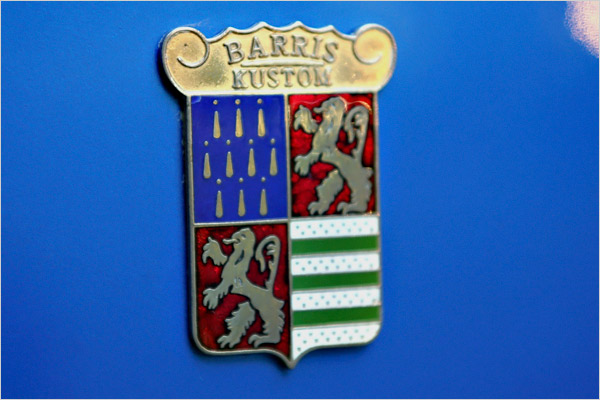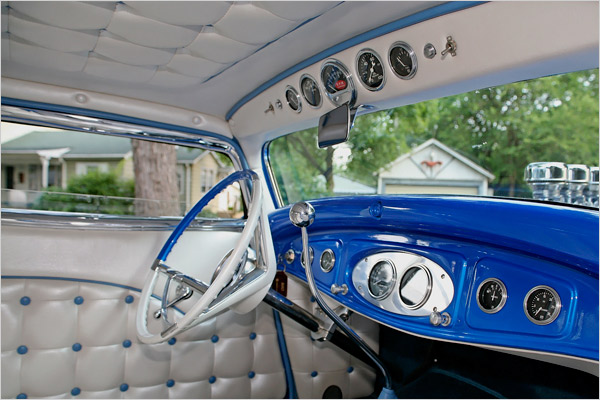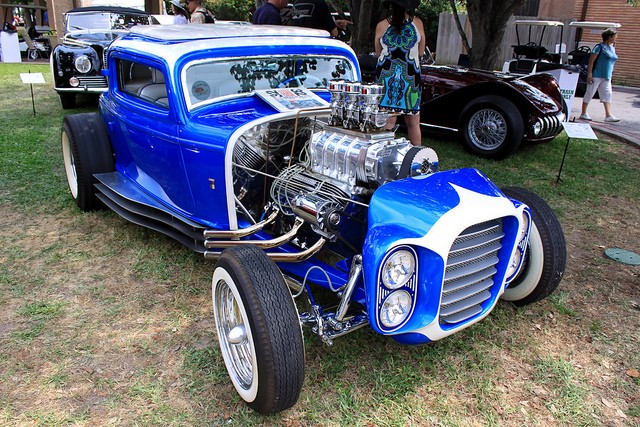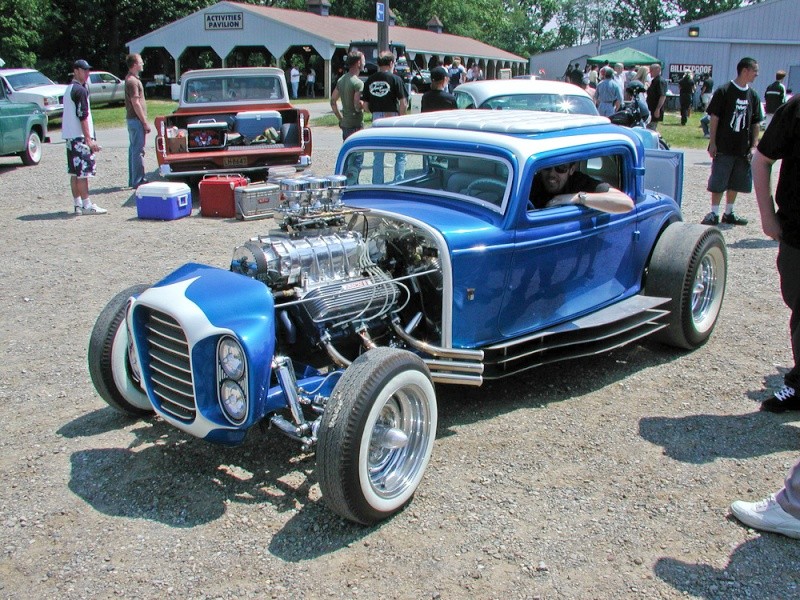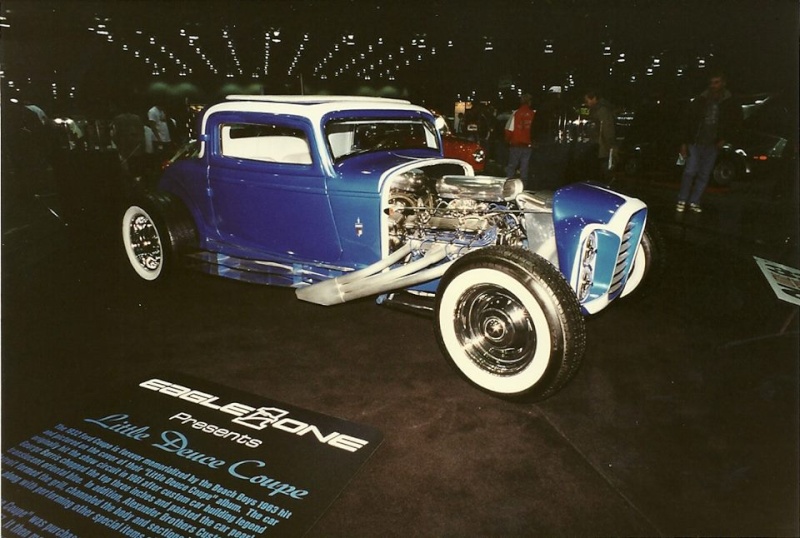The Little Deuce Coupe - The Silver Sapphire - Clarence Catallo's 1932 Ford
 The Little Deuce Coupe - The Silver Sapphire - Clarence Catallo's 1932 Ford
The Little Deuce Coupe - The Silver Sapphire - Clarence Catallo's 1932 Ford
http://www.kustomrama.com/index.php?title=Clarence_Catallo%27s_1932_Ford

1932 Ford Coupe owned by Clarence Catallo of Dearborn, Michigan. Known as the Silver Sapphire or the Little Deuce Coupe, Clarence's coupe had once been a successful drag-race career. The body had been sectioned and channeled, lowering the car a total of 7 inches. Clarence bought the car from the gas station across the street from his parents' grocery store in Allen Park, Michigan in 1956. He had to pay 75 USD for the old racer. Clarence was 15 years at the time, and without a driver license, so he had a friend drive it home for him.[2]

In 1959 Clarence brought the car to the Alexander Brothers. Mike and Larry made a new rear pan for the coupe, and fabricated a hinged front-end. An early version of the Silver Sapphire was shown at the 1959 Toledo Autorama. That version featured a modest scallop paint job, Moon discs and the stock grille shell. Later on the appearance of the car was changed drastically bu the Alexander Brothers. The bottoms of the doors were rotten, so Mike and Larry Alexander cut the bottoms off and made aluminum fins to replace the rockers. The side and rear fins were formed out of aluminum stock. An unique grille was made up from aluminum sheet stock, and featured Chevrolet headlights set inside plastic. Mike and Larry tried to talk Clarence into chopping the car, but he wouldn't go for it. The car was fit with sunken twin antennas, and by pushing on the antennas, the electric doors were opened. The car was painted in an Oldsmobile Cobalt Blue with scallops. Inside the coupe featured a white upholstered top and interior. The seats were formed of handmade frames and covered with foam rubber and blue trim. The upholstery was done by Ray Kulakowski. The steering wheel came from a 1959 Lincoln, and the column was from a 1934 Ford. Later on the Alexander Brothers fit with custom 1957 Plymouth hubcaps restyled with white plastic fins. The Alexander Brothers version of the car can be seen in the November 1962 issue of Popular Hot Rodding Magazine. Clarence was an Oldsmobile enthusiast when it came to engines, so the Coupe was powered by a 1956 Oldsmobile 344 CID V-8.

In 1959 the car ran 12.90/112mph on the drag strip.

After the Alexander Bros had done their magic to the car, Clarence moved to Long Beach for college in 1960. Clarence's parents was concerned about their son spending too much time with the wrong crowd, and offered to send him to a college anywhere in the country. Clarence chose Long Beach Community College, in the middle of the West Coast hot rod culture. Clarence headed west towing his coupe behind a ragged Oldsmobile. [2] While living in Long Beach he began to work at the Barris Kustoms Shop sweeping floors. At Barris Kustoms Junior Conway and Tubbs talked Clarence into chopping the coupe. The car received a three-inch top chop. After the top had been chopped, the car was also repainted in a lighter blue and white color. He was now focused on preparing the car for the show circuit. Clarence did not do any work on the car himself. He was smart enough to let the pros do the work. At Barris Kustoms Clarence did grunt work in exchange for work on his own car. The Barris version of the car can be seen on the cover of Hot Rod Magazine July 1961. So apparently Popular Hot Rodding Magazine kept their featured story on the Silver Sapphire on their desks for a while since their November 1962 Issue shows the previous version of the car.
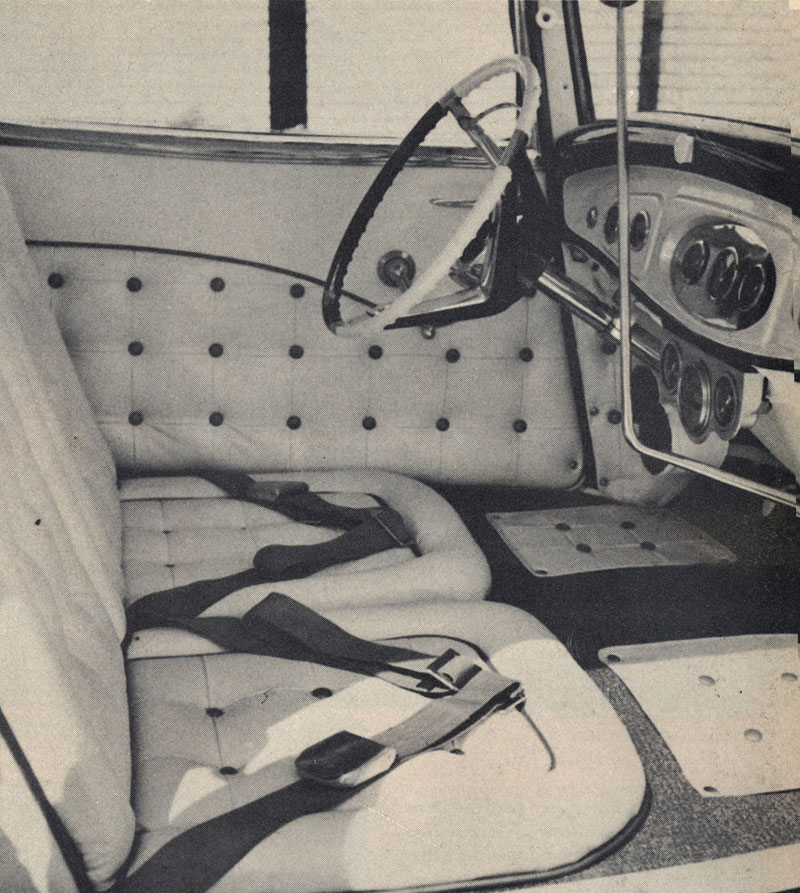
The Silver Sapphire is most famous for being pictured on the cover of the Beach Boys record "Little Deuce Coupe". Barris had built a run of about 20 candy striped dune buggies for Capitol Records. Capitol was preparing to release a new Beach Boys album which included the "Little Deuce Coupe" single. Some people at Capitol knew about Clarence's car, and when they needed a Deuce for the album cover they called George Barris.[2] The rest is history, and the Silver Sapphire ended up on the cover of the Little Deuce Coupe record wearing Barris Kustoms Crests. The album, released in October 1963, used a photograph, shot from ground level, taken for the Hot Rod layout. But this time, Clarence Catallo’s head was cropped out of the frame.[2]


1932 Ford Coupe owned by Clarence Catallo of Dearborn, Michigan. Known as the Silver Sapphire or the Little Deuce Coupe, Clarence's coupe had once been a successful drag-race career. The body had been sectioned and channeled, lowering the car a total of 7 inches. Clarence bought the car from the gas station across the street from his parents' grocery store in Allen Park, Michigan in 1956. He had to pay 75 USD for the old racer. Clarence was 15 years at the time, and without a driver license, so he had a friend drive it home for him.[2]

In 1959 Clarence brought the car to the Alexander Brothers. Mike and Larry made a new rear pan for the coupe, and fabricated a hinged front-end. An early version of the Silver Sapphire was shown at the 1959 Toledo Autorama. That version featured a modest scallop paint job, Moon discs and the stock grille shell. Later on the appearance of the car was changed drastically bu the Alexander Brothers. The bottoms of the doors were rotten, so Mike and Larry Alexander cut the bottoms off and made aluminum fins to replace the rockers. The side and rear fins were formed out of aluminum stock. An unique grille was made up from aluminum sheet stock, and featured Chevrolet headlights set inside plastic. Mike and Larry tried to talk Clarence into chopping the car, but he wouldn't go for it. The car was fit with sunken twin antennas, and by pushing on the antennas, the electric doors were opened. The car was painted in an Oldsmobile Cobalt Blue with scallops. Inside the coupe featured a white upholstered top and interior. The seats were formed of handmade frames and covered with foam rubber and blue trim. The upholstery was done by Ray Kulakowski. The steering wheel came from a 1959 Lincoln, and the column was from a 1934 Ford. Later on the Alexander Brothers fit with custom 1957 Plymouth hubcaps restyled with white plastic fins. The Alexander Brothers version of the car can be seen in the November 1962 issue of Popular Hot Rodding Magazine. Clarence was an Oldsmobile enthusiast when it came to engines, so the Coupe was powered by a 1956 Oldsmobile 344 CID V-8.

In 1959 the car ran 12.90/112mph on the drag strip.

After the Alexander Bros had done their magic to the car, Clarence moved to Long Beach for college in 1960. Clarence's parents was concerned about their son spending too much time with the wrong crowd, and offered to send him to a college anywhere in the country. Clarence chose Long Beach Community College, in the middle of the West Coast hot rod culture. Clarence headed west towing his coupe behind a ragged Oldsmobile. [2] While living in Long Beach he began to work at the Barris Kustoms Shop sweeping floors. At Barris Kustoms Junior Conway and Tubbs talked Clarence into chopping the coupe. The car received a three-inch top chop. After the top had been chopped, the car was also repainted in a lighter blue and white color. He was now focused on preparing the car for the show circuit. Clarence did not do any work on the car himself. He was smart enough to let the pros do the work. At Barris Kustoms Clarence did grunt work in exchange for work on his own car. The Barris version of the car can be seen on the cover of Hot Rod Magazine July 1961. So apparently Popular Hot Rodding Magazine kept their featured story on the Silver Sapphire on their desks for a while since their November 1962 Issue shows the previous version of the car.

The Silver Sapphire is most famous for being pictured on the cover of the Beach Boys record "Little Deuce Coupe". Barris had built a run of about 20 candy striped dune buggies for Capitol Records. Capitol was preparing to release a new Beach Boys album which included the "Little Deuce Coupe" single. Some people at Capitol knew about Clarence's car, and when they needed a Deuce for the album cover they called George Barris.[2] The rest is history, and the Silver Sapphire ended up on the cover of the Little Deuce Coupe record wearing Barris Kustoms Crests. The album, released in October 1963, used a photograph, shot from ground level, taken for the Hot Rod layout. But this time, Clarence Catallo’s head was cropped out of the frame.[2]

Dernière édition par Predicta le Jeu 28 Fév - 7:37, édité 1 fois
_________________
We don't care the People Says , Rock 'n' roll is here to stay - Danny & the Juniors - 1958
 Re: The Little Deuce Coupe - The Silver Sapphire - Clarence Catallo's 1932 Ford
Re: The Little Deuce Coupe - The Silver Sapphire - Clarence Catallo's 1932 Ford
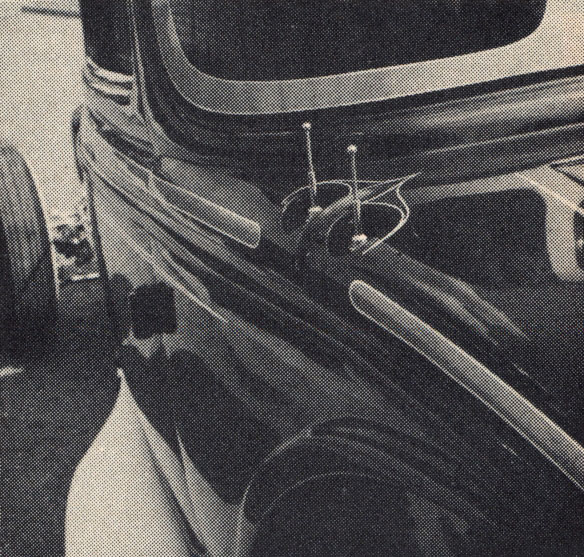
Clarence Catallo returned to Detroit, finished college and settled into a job in the financial industry. In 1965 he sold the Silver Sapphire so he could buy a Porsche.

Curt Catallo, Clarence's son, convinced his father to track down the car and get it back in the family. The car was traced to Long Island, and Bob Larivee Jr. of Championship Auto Shows contacted the owner, who didn’t want to part with the Little Deuce Coupe. Bob leased the car for a year to be used as an attraction in their custom car shows. At the end of the lease, in 1998 the owner of the car agreed to sell it to Bob for $40,000. Clarence wanted the car, and gave Bob the check. Back in the Catallo family again, the car was restored back to its former glory. The Oldsmobile engine had been replaced with a Chrysler V8, but the previous owner had fortunately held onto many of the parts removed or replaced over the years. The goal was to get the car ready for the Meadow Brook Concours d’Élégance in August 2000. But Clarence Catallo’s death in 1998 left the coupe’s restoration to his son and daughter. Curt Catallo enlisted the help of Mike Alexander and other craftsmen who originally worked on the car to complete its overhaul, with the intention of making the car appear exactly as it did on the album. The team finished just in time. Fittingly, the coupe took the People’s Choice award at Meadow Brook in 2000. The car is still in the Catallo family today.[2]
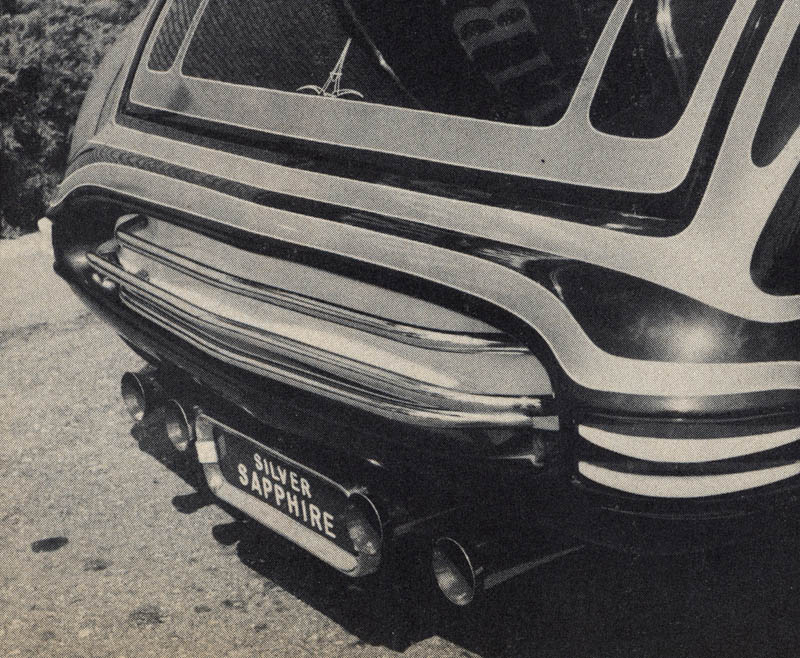
In May of 2013 the car went to the Gilmore Car Museum in Hickory Corner, Michigan for a year on display. A total of 21 cars were part of the display. The theme of the display was the 1950s and the 1960s nostalgia periode.[3]

Magazine Features
Rodding & Re-styling May 1961
Hot Rod Magazine July 1961
Popular Hot Rodding November 1962
Hop-Up November 1963
Street Rod Builder May 2001
Rodders Journal Number 36

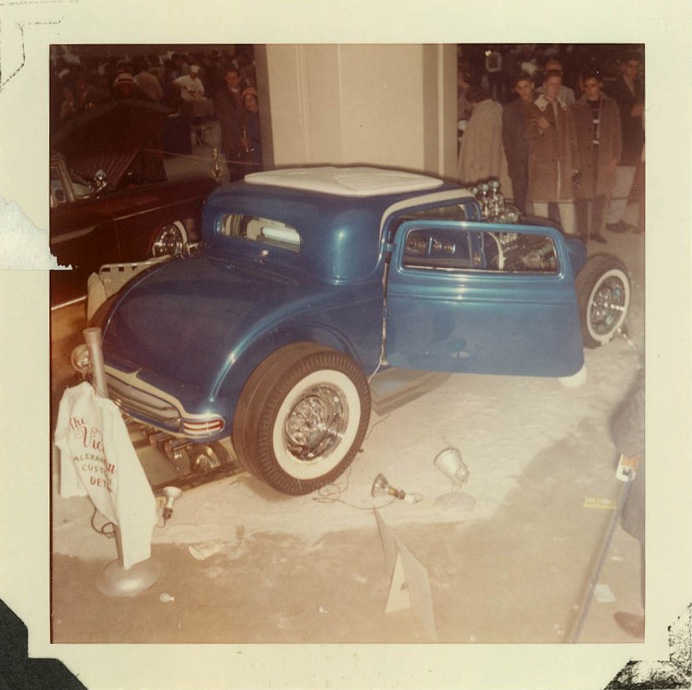
_________________
We don't care the People Says , Rock 'n' roll is here to stay - Danny & the Juniors - 1958
 Re: The Little Deuce Coupe - The Silver Sapphire - Clarence Catallo's 1932 Ford
Re: The Little Deuce Coupe - The Silver Sapphire - Clarence Catallo's 1932 Ford
_________________
We don't care the People Says , Rock 'n' roll is here to stay - Danny & the Juniors - 1958
 Re: The Little Deuce Coupe - The Silver Sapphire - Clarence Catallo's 1932 Ford
Re: The Little Deuce Coupe - The Silver Sapphire - Clarence Catallo's 1932 Ford
_________________
We don't care the People Says , Rock 'n' roll is here to stay - Danny & the Juniors - 1958
 Re: The Little Deuce Coupe - The Silver Sapphire - Clarence Catallo's 1932 Ford
Re: The Little Deuce Coupe - The Silver Sapphire - Clarence Catallo's 1932 Ford

Avec leur chanson Little Deuce Coupe, les Beach Boys chantaient les louanges du coupé Ford 32. Sur la pochette de l’album trônait fièrement le rod choppé et channelé de Clarence « Chili » Catallo, qui fit également, en juillet 1961, la une du magazine Hot Rod. Catallo, qui avait commencé à construire ce rod à l’âge de 15 ans, lui fit atteindre le haut des 12 secondes sur la piste de drag grâce à un V8 Oldsmobile à compresseur, tout en s’en servant pour rouler tous les jours. Il confia par la suite la voiture à l’atelier des Alexander Brothers, à Detroit, pour des modifications radicales. C’est là que furent effectués le channeling, le raccourcissement des portes, la pose des lames de bas de caisse, l’entourage de calandre et le panneau arrière assorti. Le rod rafla quelques coupes à des manifestations locales, puis suivit Catallo, parti en Californie effectuer ses études tout en travaillant chez Barris. Le rod subit alors un top-chop et fut recouvert de la teinte bleu nacré à scallops blancs qu’il porte encore aujourd’hui.
Cette voiture a fait l’objet d’un article de 4 pages dans Nitro 183, avec un texte et des photos de David Fetherston.
Retrouvez le reportage de 6 pages sur les 75 ans du Deuce au Grand National Roadster Show dans Nitro 227 d’avril-mai 2007, avec des photos et un texte de Stéphane Szantaï.
Dans la vidéo ci-dessous, Curt Catallo relate la création et les tribulations de ce coupé Ford 32 construit par son père et aujourd’hui légendaire.

http://www.nitromag.fr/2011/12/le-rod-ford-32-du-mois-little-deuce-coupe/
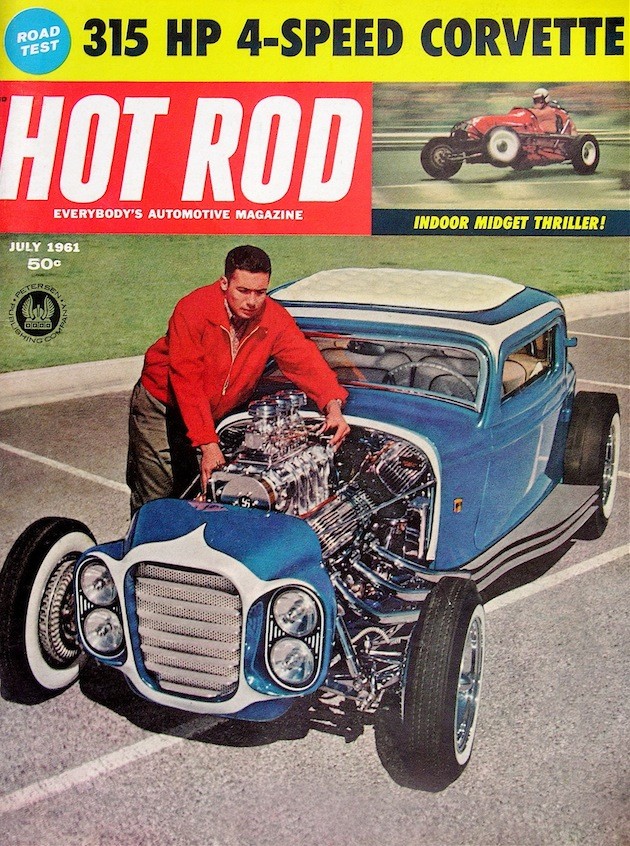
http://www.nitromag.fr/2011/12/le-rod-ford-32-du-mois-little-deuce-coupe/
_________________
We don't care the People Says , Rock 'n' roll is here to stay - Danny & the Juniors - 1958
 Re: The Little Deuce Coupe - The Silver Sapphire - Clarence Catallo's 1932 Ford
Re: The Little Deuce Coupe - The Silver Sapphire - Clarence Catallo's 1932 Ford
http://www.gregwapling.com/hotrod/hot-rod-history/lil-deuce-coupe.html

Curt Catallo of Clarkston owns the "Little Deuce Coupe." His dad, when he was a teenager, found this car in a field Downriver in the mid-1950s. This vehicle went on to become one of the most iconic Deuce Coupes of all times, gracing a Beach Boys' "Little Deuce Coupe" album cover and the cover of an early issue of Hot Rod magazine.




“Little Deuce Coupe, you don’t know, you don’t know what I got.” Even if you weren’t a hot rodder in the 1960s, you’d recognize this snazzy, scalloped ‘32 coupe. It first appeared on the July 1961 cover of Hot Rod. Not long afterward, Eric Rickman’s lead photo in that story, sans the car owner’s head and shoulders, became a best-selling Beach Boys’ record album cover. Little matter that the “actual” ‘32 in the catchy tune boasted “…a flathead mill and four on the floor,” and the album cover car was powered by a blown Olds – this radical three-window was, and always will be, the quintessential, “Little Deuce Coupe.”
Clarence Catallo, of Dearborn, Michigan, purchased this car for just $75 in 1956 when he was just 15 years old. It was sitting in a gas station across from his parents’ small grocery store in Allen Park, a working-class suburb of Detroit. A friend had to drive it home for him because young Catallo didn’t yet have his drivers’ license. But that technicality didn’t stop him from getting right to work on a car that was to become one of the most famous deuce coupes of all time.
He started by channeling the car a full six inches, then he painted it dark blue and dropped in a carbureted OHV Olds V-8. By the time Catallo was licensed to drive, he had built quite a ride. Early photos of this car show it out at Detroit Dragway in 1958. A McCulloch supercharger hunkers on top of the Olds engine, making the power plant and accessories look as though they were forced into the abbreviated engine compartment with a whip and a chair. Flex-pipe headers and chromed, reversed wheels, with slicks on the rear, showed this coupe meant business. Catallo apparently drag-raced the wheels off this car, continuously perfecting the bored-out, 344-ci Olds, originally built by Bill Wanderer. The coupe ran sub-13-second quarter miles, turning a best trap speed of 112 mph.
The grille in those early days was a full-sized, filled ‘32 item. The front frame horns were bobbed, there was no front spreader bar, and a pair of tiny headlights was perched atop accessory aluminum brackets. Catallo’s car epitomized a minimalist look that soon appeared all across the country, especially from the East Coast to the Midwest. Although it was a complex modification, channeling was often the first thing done to make a deuce a hot rod, particularly back East. But Catallo went even further. He modified the coupe’s rear fender wells to closely follow the outline of its big rear 8.20 x 15-inch Inglewood slicks, accenting the car’s lowness and making it look even racier.
Clarence Catallo sold the car for either $5,200 or $5,500, we’re not sure, not long after its Beach Boys album cover appearance, reportedly because he had done everything he wanted to do to it. Owned at first by the Washington Timing Association, a Pennsylvania car club, the coupe appeared in several major shows, notably the 1962 ICAS Grand Finale at the National Guard Armory in Washington, D.C., and then it was sold again briefly to a buyer from Montreal, Canada. But another phase of its life was about to begin. Ray Woloszak, from Long Island, New York, was the car’s next owner, around 1965. He converted the show car into a street rod and replaced the GMC blower and three-carb setup with a single four-barrel carburetor. Woloszak also removed the distinctive side strakes and installed exhaust headers that ran over the frame and along the sides.
In the late 1990s, Curt Catallo, Clarence’s son, persuaded his father to find and purchase his old coupe. “As a kid,“ Curt says, “I knew the trophies before I knew the car. Many of them were my height. And it seemed like we had acres of them stored in an attic. Finally, most of them were thrown away, but we kept a few, probably because I had them in a tree house.”
“I thought it was great that my dad had a cool car that won a lot of trophies. He sold it before he met my mother. A few years ago, I really got under my dad’s skin about it. I thought of the coupe like a family heirloom that should be preserved. Fortunately, Bob Larivee, Jr. helped us find it. Without him, we never would have gotten it back.”
Bob Larivee, Jr. actually bought the Catallo coupe from Ray Woloszak in 1999, for about $40,000, and he initially planned to continue to use it, as a feature attraction, in his family’s car shows. His dad, Bob Larivee, Sr., recalls, “Clarence was the nicest guy. I knew him when he first built the car. He eventually became a top-ranked executive with E. F. Hutton, but he had no pretensions whatsoever. Back when he initially owned the car, we rented it for our shows. Clarence was always a terrific person to deal with.”
Shortly after they purchased the coupe, the Larivees’ decided the car had been exposed sufficiently for the time being. They elected to sell it back to Clarence Catallo, who immediately started collecting the correct parts to restore it to its earlier Hot Rod cover car guise. “When my dad got the car back, and saw there was a Chrysler engine in it, he got fired up to do it right. We were in touch with the Alexander Brothers and George Barris. Dad wanted to preserve what they had done. Fortunately for us, Ray Woloszak had saved a lot of the parts he took off the car. That meant the world to me.”
“I underestimated the effect this car had,” Curt Catallo says today. “The right guys touched this car and it touched a lot of people. Guys would come up to me and say they’d seen it back in the day, or that they’d built the Aurora model of it. It was great that it won the People’s Choice award, because the people are the ones my dad built it for.”
Back in the family again, the Little Deuce Coupe rests proudly in the carriage house behind their converted church home. Somewhere, I’d like to think that Clarence “Chili” Catallo is smiling.
Taken from Ken Gross & Rober Genat's Hot Rod Milestones: America's Coolest Coupes, Roadsters, & Racers (published 2005)


Curt Catallo of Clarkston owns the "Little Deuce Coupe." His dad, when he was a teenager, found this car in a field Downriver in the mid-1950s. This vehicle went on to become one of the most iconic Deuce Coupes of all times, gracing a Beach Boys' "Little Deuce Coupe" album cover and the cover of an early issue of Hot Rod magazine.




“Little Deuce Coupe, you don’t know, you don’t know what I got.” Even if you weren’t a hot rodder in the 1960s, you’d recognize this snazzy, scalloped ‘32 coupe. It first appeared on the July 1961 cover of Hot Rod. Not long afterward, Eric Rickman’s lead photo in that story, sans the car owner’s head and shoulders, became a best-selling Beach Boys’ record album cover. Little matter that the “actual” ‘32 in the catchy tune boasted “…a flathead mill and four on the floor,” and the album cover car was powered by a blown Olds – this radical three-window was, and always will be, the quintessential, “Little Deuce Coupe.”
Clarence Catallo, of Dearborn, Michigan, purchased this car for just $75 in 1956 when he was just 15 years old. It was sitting in a gas station across from his parents’ small grocery store in Allen Park, a working-class suburb of Detroit. A friend had to drive it home for him because young Catallo didn’t yet have his drivers’ license. But that technicality didn’t stop him from getting right to work on a car that was to become one of the most famous deuce coupes of all time.
He started by channeling the car a full six inches, then he painted it dark blue and dropped in a carbureted OHV Olds V-8. By the time Catallo was licensed to drive, he had built quite a ride. Early photos of this car show it out at Detroit Dragway in 1958. A McCulloch supercharger hunkers on top of the Olds engine, making the power plant and accessories look as though they were forced into the abbreviated engine compartment with a whip and a chair. Flex-pipe headers and chromed, reversed wheels, with slicks on the rear, showed this coupe meant business. Catallo apparently drag-raced the wheels off this car, continuously perfecting the bored-out, 344-ci Olds, originally built by Bill Wanderer. The coupe ran sub-13-second quarter miles, turning a best trap speed of 112 mph.
The grille in those early days was a full-sized, filled ‘32 item. The front frame horns were bobbed, there was no front spreader bar, and a pair of tiny headlights was perched atop accessory aluminum brackets. Catallo’s car epitomized a minimalist look that soon appeared all across the country, especially from the East Coast to the Midwest. Although it was a complex modification, channeling was often the first thing done to make a deuce a hot rod, particularly back East. But Catallo went even further. He modified the coupe’s rear fender wells to closely follow the outline of its big rear 8.20 x 15-inch Inglewood slicks, accenting the car’s lowness and making it look even racier.
Clarence Catallo sold the car for either $5,200 or $5,500, we’re not sure, not long after its Beach Boys album cover appearance, reportedly because he had done everything he wanted to do to it. Owned at first by the Washington Timing Association, a Pennsylvania car club, the coupe appeared in several major shows, notably the 1962 ICAS Grand Finale at the National Guard Armory in Washington, D.C., and then it was sold again briefly to a buyer from Montreal, Canada. But another phase of its life was about to begin. Ray Woloszak, from Long Island, New York, was the car’s next owner, around 1965. He converted the show car into a street rod and replaced the GMC blower and three-carb setup with a single four-barrel carburetor. Woloszak also removed the distinctive side strakes and installed exhaust headers that ran over the frame and along the sides.
In the late 1990s, Curt Catallo, Clarence’s son, persuaded his father to find and purchase his old coupe. “As a kid,“ Curt says, “I knew the trophies before I knew the car. Many of them were my height. And it seemed like we had acres of them stored in an attic. Finally, most of them were thrown away, but we kept a few, probably because I had them in a tree house.”
“I thought it was great that my dad had a cool car that won a lot of trophies. He sold it before he met my mother. A few years ago, I really got under my dad’s skin about it. I thought of the coupe like a family heirloom that should be preserved. Fortunately, Bob Larivee, Jr. helped us find it. Without him, we never would have gotten it back.”
Bob Larivee, Jr. actually bought the Catallo coupe from Ray Woloszak in 1999, for about $40,000, and he initially planned to continue to use it, as a feature attraction, in his family’s car shows. His dad, Bob Larivee, Sr., recalls, “Clarence was the nicest guy. I knew him when he first built the car. He eventually became a top-ranked executive with E. F. Hutton, but he had no pretensions whatsoever. Back when he initially owned the car, we rented it for our shows. Clarence was always a terrific person to deal with.”
Shortly after they purchased the coupe, the Larivees’ decided the car had been exposed sufficiently for the time being. They elected to sell it back to Clarence Catallo, who immediately started collecting the correct parts to restore it to its earlier Hot Rod cover car guise. “When my dad got the car back, and saw there was a Chrysler engine in it, he got fired up to do it right. We were in touch with the Alexander Brothers and George Barris. Dad wanted to preserve what they had done. Fortunately for us, Ray Woloszak had saved a lot of the parts he took off the car. That meant the world to me.”
“I underestimated the effect this car had,” Curt Catallo says today. “The right guys touched this car and it touched a lot of people. Guys would come up to me and say they’d seen it back in the day, or that they’d built the Aurora model of it. It was great that it won the People’s Choice award, because the people are the ones my dad built it for.”
Back in the family again, the Little Deuce Coupe rests proudly in the carriage house behind their converted church home. Somewhere, I’d like to think that Clarence “Chili” Catallo is smiling.
Taken from Ken Gross & Rober Genat's Hot Rod Milestones: America's Coolest Coupes, Roadsters, & Racers (published 2005)

_________________
We don't care the People Says , Rock 'n' roll is here to stay - Danny & the Juniors - 1958
 Re: The Little Deuce Coupe - The Silver Sapphire - Clarence Catallo's 1932 Ford
Re: The Little Deuce Coupe - The Silver Sapphire - Clarence Catallo's 1932 Ford
La drôle d’histoire de "the Little Deuce Coupe"
Cette pochette mythique de l’album des Beach Boys « Little Deuce Coupe » m’a toujours intrigué : je ne suis pas passionné par les « hotrods » mais je dois avouer que celui-ci avait de la gueule, et quelque chose de tellement « beach boys ». Aussi me suis-je renseigné, pour en savoir un peu plus ce coupé Ford 32 et sur cet album intimement lié à l’automobile.
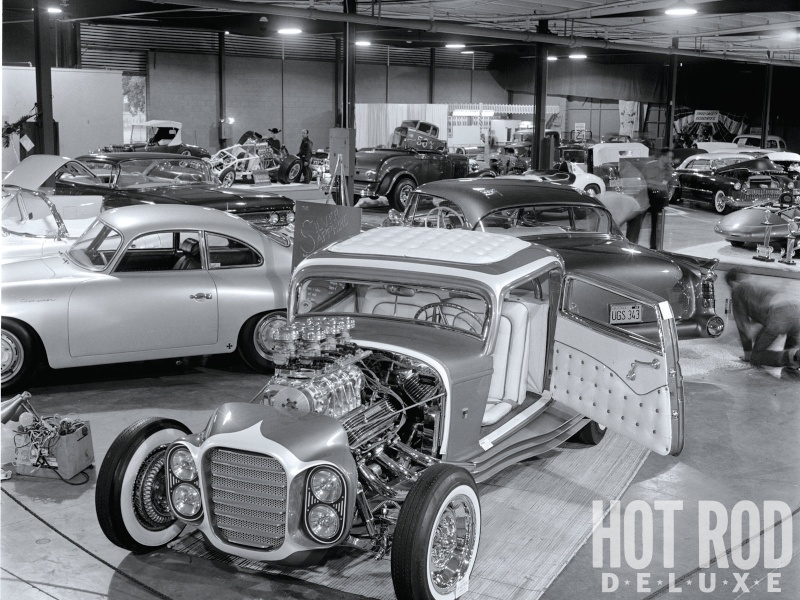
La chanson en elle-même, Little Deuce Coupe, est parue avant l’album éponyme. En 1963, moins de 3 mois après la parution du précédent album, Surfer Girl, les Beach Boys découvrent une compilation « hotrod » utilisant pas moins de 4 de leurs chansons évoquant la bagnole : « Little deuce coupe », « 409 », « Our car club » et « Shut down ». En réaction, ils lancent cet album imprévu, qui reprend le titre Little Deuce Coupe, un opus totalement dédié à l’automobile.
La chanson phare de cet album évoque un hotrod sur base de Ford 32 (le fameux « petit coupé 32 »). Il y est question d’un mec parlant à sa copine de sa voiture, qu’il semble lui préférer. Les paroles sont évocatrices :
« C’est juste un petit coupé 32 avec un moteur flathead
Mais il doublerait une Thunderbird comme si elle était à l’arrêt
Culasses et conduits travaillés, réalésés, course allongée
Il dépasse les 220 quand je mets le pied au plancher.
Un petit coupé 32,
Tu ne te rends pas compte de ce que j’ai… »
J’imagine la tête de la jeune fille en entendant ces paroles. Au lieu d’une déclaration d’amour, on lui parle de culasse réalésées. Surtout, la mélodie et les voix des Beach Boys sont en total décalage avec le côté brut et mécanique du Hotrod. C’est peut-être d’ailleurs cela qui rend cette chanson si réussie.
Toujours est-il qu’il faut trouver une illustration pour la pochette de cet album réalisé à la va-vite. En 1961, le magazine Hotrod avait mis en couverture la voiture d’un ptit gars passionné, un coupé Ford 32 qu’il a commencé à bricoler en 1955.

De couleur bleue, moteur apparent (un V8 Oldsmobile de 5 litres), agrémenté de liserés blancs entourant la calandre, elle est photogénique à souhait. La voiture de Clarence « Chili » Catallo (alors surnommée « the Silver Sapphire ») allait ainsi passer à la postérité, choisie par les Beach Boys eux aussi passionnés de hotrods (comme beaucoup de californiens de l’époque).
Aujourd’hui, la « little deuce coupe » (les américains ont fait tomber l’accent de « coupé ») est elle aussi devenue une vedette, et existe toujours. Chili l’avait vendue en 1965, et elle passa entre de nombreuses mains avant qu’il ne la rachète finalement en 1997, encouragé par son fils Curt. Malheureusement, Chili décéda peu après, et c’est Curt qui entrepris la restauration de ce célèbre Hotrod, avec l’aide de la General Motors (pour la restauration du moteur Oldsmobile). En 2002, la voiture était à nouveau en état « d’origine » (si l’on peut dire cela d’un hotrod).
http://boitierrouge.wordpress.com/2014/06/09/la-drole-dhistoire-de-the-little-deuce-coupe/
Cette pochette mythique de l’album des Beach Boys « Little Deuce Coupe » m’a toujours intrigué : je ne suis pas passionné par les « hotrods » mais je dois avouer que celui-ci avait de la gueule, et quelque chose de tellement « beach boys ». Aussi me suis-je renseigné, pour en savoir un peu plus ce coupé Ford 32 et sur cet album intimement lié à l’automobile.

La chanson en elle-même, Little Deuce Coupe, est parue avant l’album éponyme. En 1963, moins de 3 mois après la parution du précédent album, Surfer Girl, les Beach Boys découvrent une compilation « hotrod » utilisant pas moins de 4 de leurs chansons évoquant la bagnole : « Little deuce coupe », « 409 », « Our car club » et « Shut down ». En réaction, ils lancent cet album imprévu, qui reprend le titre Little Deuce Coupe, un opus totalement dédié à l’automobile.
La chanson phare de cet album évoque un hotrod sur base de Ford 32 (le fameux « petit coupé 32 »). Il y est question d’un mec parlant à sa copine de sa voiture, qu’il semble lui préférer. Les paroles sont évocatrices :
« C’est juste un petit coupé 32 avec un moteur flathead
Mais il doublerait une Thunderbird comme si elle était à l’arrêt
Culasses et conduits travaillés, réalésés, course allongée
Il dépasse les 220 quand je mets le pied au plancher.
Un petit coupé 32,
Tu ne te rends pas compte de ce que j’ai… »
J’imagine la tête de la jeune fille en entendant ces paroles. Au lieu d’une déclaration d’amour, on lui parle de culasse réalésées. Surtout, la mélodie et les voix des Beach Boys sont en total décalage avec le côté brut et mécanique du Hotrod. C’est peut-être d’ailleurs cela qui rend cette chanson si réussie.
Toujours est-il qu’il faut trouver une illustration pour la pochette de cet album réalisé à la va-vite. En 1961, le magazine Hotrod avait mis en couverture la voiture d’un ptit gars passionné, un coupé Ford 32 qu’il a commencé à bricoler en 1955.

De couleur bleue, moteur apparent (un V8 Oldsmobile de 5 litres), agrémenté de liserés blancs entourant la calandre, elle est photogénique à souhait. La voiture de Clarence « Chili » Catallo (alors surnommée « the Silver Sapphire ») allait ainsi passer à la postérité, choisie par les Beach Boys eux aussi passionnés de hotrods (comme beaucoup de californiens de l’époque).
Aujourd’hui, la « little deuce coupe » (les américains ont fait tomber l’accent de « coupé ») est elle aussi devenue une vedette, et existe toujours. Chili l’avait vendue en 1965, et elle passa entre de nombreuses mains avant qu’il ne la rachète finalement en 1997, encouragé par son fils Curt. Malheureusement, Chili décéda peu après, et c’est Curt qui entrepris la restauration de ce célèbre Hotrod, avec l’aide de la General Motors (pour la restauration du moteur Oldsmobile). En 2002, la voiture était à nouveau en état « d’origine » (si l’on peut dire cela d’un hotrod).
http://boitierrouge.wordpress.com/2014/06/09/la-drole-dhistoire-de-the-little-deuce-coupe/
_________________
We don't care the People Says , Rock 'n' roll is here to stay - Danny & the Juniors - 1958
 Re: The Little Deuce Coupe - The Silver Sapphire - Clarence Catallo's 1932 Ford
Re: The Little Deuce Coupe - The Silver Sapphire - Clarence Catallo's 1932 Ford

Is there a more famous ’32 three-window than Clarence “Chili” Catallo’s custom coupe? We think not, thanks to its appearances on the covers of both HRM and, two years later, the fourth Beach Boys album. The platinum-selling Little Deuce Coupe LP made it all the way to Number Four on the Billboard chart and into more than a million American homes. Most of those record buyers didn’t know a ’32 Ford from a Model T, but they all knew Chili’s three-window as the Deuce coupe.

Ironically, this particular car had nothing to do with inspiring the album or its title track—a B-side (backing Surfer Girl) that surprisingly shot to No. 15 in singles sales, the highest position for any Beach Boys flip side. All they had in common was a March 1961 photo session with Eric Rickman (who went unnamed on the album cover, which credits only HOT ROD magazine). Why Capitol Records clumsily cropped out Chili’s head and shoulders is, like the omission of the photographer’s name, a mystery lost to the ages.
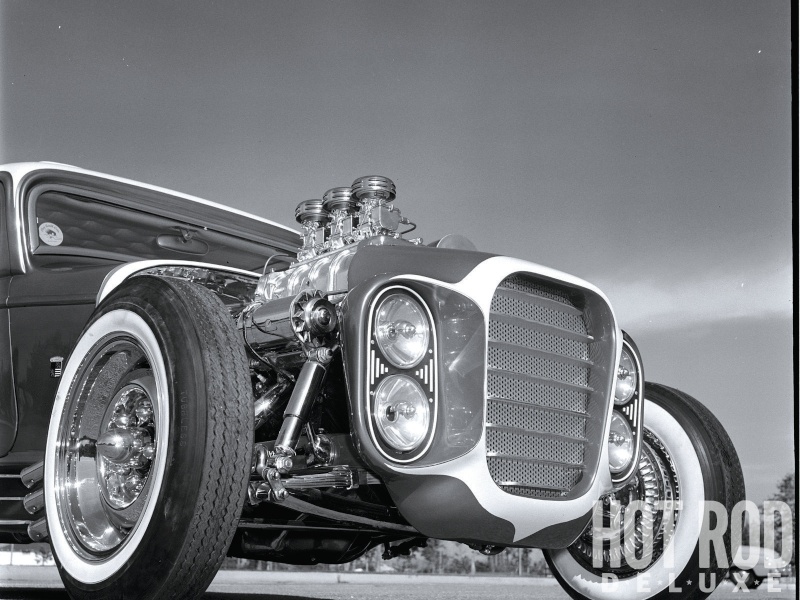
The other major difference between the two famous cover images is Chili’s jacket. No, the weather in Los Angeles didn’t suddenly turn, uh, chilly between setups. According to Greg Sharp, our man Rick was fretting about the car’s lack of bright colors when Ed Roth happened to drive up, wearing a red jacket embroidered with the name “Ed.” Alas, that detail has faded from your editor’s half-century-old magazine and LP, but another subtle feature did not: a white swastika in the center of the blower pulley. Evidently, nobody at politically correct HRM noticed until reader mail started arriving.

_________________
We don't care the People Says , Rock 'n' roll is here to stay - Danny & the Juniors - 1958
 Re: The Little Deuce Coupe - The Silver Sapphire - Clarence Catallo's 1932 Ford
Re: The Little Deuce Coupe - The Silver Sapphire - Clarence Catallo's 1932 Ford
_________________
We don't care the People Says , Rock 'n' roll is here to stay - Danny & the Juniors - 1958
 Re: The Little Deuce Coupe - The Silver Sapphire - Clarence Catallo's 1932 Ford
Re: The Little Deuce Coupe - The Silver Sapphire - Clarence Catallo's 1932 Ford
_________________
We don't care the People Says , Rock 'n' roll is here to stay - Danny & the Juniors - 1958
 Re: The Little Deuce Coupe - The Silver Sapphire - Clarence Catallo's 1932 Ford
Re: The Little Deuce Coupe - The Silver Sapphire - Clarence Catallo's 1932 Ford
_________________
We don't care the People Says , Rock 'n' roll is here to stay - Danny & the Juniors - 1958
 Re: The Little Deuce Coupe - The Silver Sapphire - Clarence Catallo's 1932 Ford
Re: The Little Deuce Coupe - The Silver Sapphire - Clarence Catallo's 1932 Ford
_________________
We don't care the People Says , Rock 'n' roll is here to stay - Danny & the Juniors - 1958
 Sujets similaires
Sujets similaires» International Championship Auto Show Program, 1962
» 1932 Ford hot rod
» Rock and road disques avec une voiture sur la pochette
» Ford 1932 coupe hot rod hiboy - Deuce Wild - 100% Hot Wheels collectibles
» 1932 Ford Deuce Five-Window - Sport Coupe - Street or Drag Strip Hot Rod - 1:24 scale - Monogram
» 1932 Ford hot rod
» Rock and road disques avec une voiture sur la pochette
» Ford 1932 coupe hot rod hiboy - Deuce Wild - 100% Hot Wheels collectibles
» 1932 Ford Deuce Five-Window - Sport Coupe - Street or Drag Strip Hot Rod - 1:24 scale - Monogram
Permission de ce forum:
Vous ne pouvez pas répondre aux sujets dans ce forum
 Connexion
Connexion







